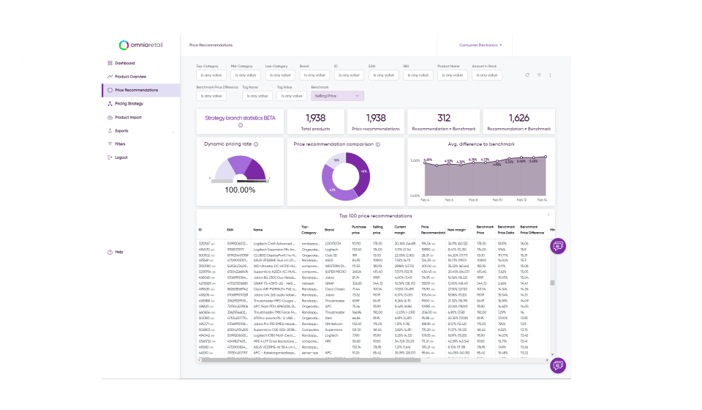Europe’s e-commerce and pricing event of the year is returning in 2024, as Omnia Retail gears up for another exciting edition of Price Points Live. As leaders in e-commerce pricing across Europe, Omnia Retail is perfectly positioned to bring together experts and leaders in retail, pricing, marketing and branding to share insights and knowledge. Taking place at the modern Capital C building in Amsterdam on 7 March 2024, the building’s majestic glass dome ceiling sets the tone fittingly for this year’s main topic: Transparency.
Whether it be transparency in pricing, marketing or e-commerce practices, our panel of speakers bring more than a century of collective knowledge and experience to the table. Joining us is Prof. Hermann Simon, the co-founder and chairman of Simon-Kucher who is returning to Price Points Live for a second visit. Known as the world’s leading expert on pricing and growth consulting, Prof. Simon is an award-winning author.
Also on this year’s stage is Natalie Berg - an analyst, author and podcast host - who will add value to the conversation on all things global retail. Dr Doug Mattheus, a business executive and consultant, will be bringing his 35-years of knowledge and experience in marketing, retail and branding. Lastly, Cor Verhoeven is a Group Product Manager at one of Europe's largest marketplaces, Bol.com, specialising in pricing and assortment insights. He’ll be bringing his entrepreneurial spirit and his 10-plus years of e-commerce, product management and marketplace experience to Price Points Live. Our speakers will be brought together by the charming Suyin Aerts, who is also a returning panel member.
Challenges in today’s world of e-commerce
What are brands and enterprises facing in e-commerce in 2024? From branding to pricing to consumer behaviour, the e-commerce arena has experienced more phases and changes in the last four years that it did in the previous decade. Let’s discuss some of the industry’s key trends and issues as of today.
Growing competition and price-war strategies
As e-commerce grows and oversaturates each vertical, consumers have more choice and power. This is not necessarily a bad thing, however, it does mean that brands and retailers start employing more competitive pricing strategies that ultimately lead to price wars between competitors and a race to the bottom. This undercuts the value of products and only results in losses for each business involved. This has been evident with smartphone brands like Samsung and Huawei who competitively lower the prices of their smartphones to achieve higher market share. It’s also common between wholesale retailers like CostCo and IKEA or large online marketplaces like Amazon that employ tactics to get their vendors to sell their products lower than on any other marketplace.
Increased customer expectations
For decades, the relationship between retailers and consumers had been dominated by the former. Customers had only a few options for where they trusted to purchase their groceries, shoes, school supplies, winter essentials and everything in between. Today, that relationship has been flipped on its head as consumers enjoy the pick of the litter in just about every retail vertical. As this trend has developed, consumers have come to expect faster shipping, better prices, higher quality, and more benefits for their loyalty. This will naturally affect a brand or retailer’s pricing strategies as they try to maintain customer retention and even attract new customers with promotions, benefits from loyalty programs and clubs, and bundles that appeal to shoppers.
Changing customer loyalty
What makes a customer loyal to a brand? At what point does a customer’s loyalty erode? And, what are the factors that could cause this to happen? For most customers, it’s a balancing act between quality and cost. However, in 2024, brands and enterprises must face other factors that could affect customer loyalty: Sustainability efforts. A 2023 McKinsey and NielsenIQ study found that products with ESG claims (environmental, social or governance) accounted for 56% of the total sales growth during the five-year period of the study, from 2017 - mid-2022, showing, for the first time, that brands with some kind of sustainability mention are growing faster than those without. This is all due to changing customer loyalty and the very parameters that shape and shift that loyalty. Social changes may be another factor. For example, in the sporting goods vertical, participation in social sports like pickleball and paddle tennis have increased by 159% while lacrosse, skiing and track declined by 11%, 14% and 11% respectively.
Stubborn inflation
The issue that has plagued global e-commerce since 2021 is still having its ripple effects on the industry in 2024. In the first quarter of 2024, the EU has already cut GDP growth expectations for the year from 1.3% to 0.9% as interest rates remain high while consumers still grapple with a 40% increase in gas and food prices that peaked in 2023. With this reality, pricing has never been more important nor more sensitive to the consumer. McKinsey’s latest ConsumerWatch report shows that shoppers were buying less items at the end of 2023 compared to the previous year’s period, with personal care dropping 3%, household items dropping 3% and pet care dropping 5% which results in AOV (average order value) loss.
The importance of transparency in pricing software
The use of dynamic pricing in e-commerce has grown exponentially in the last decade, however, that does not mean every software provider offers the best-in-class platform. Not every pricing tool is made equally. Transparency is something that has not been prioritised as a core tenet of pricing software, which has often allowed for a murky relationship between a brand or enterprise and their own pricing strategies. For a user of pricing software to experience the full potential of a pricing tool, they need to be able to build, test and edit each pricing strategy with clarity and ease. They need to be able to understand how and why a pricing recommendation has been made. They should be physically able to see every pricing strategy simultaneously at play without convolution or confusing coding jargon. While this may seem obvious, some pricing platforms have found that withholding pricing knowledge from a customer is the way to go.
How is Omnia enhancing transparency?
When Omnia set out to build its new pricing tool, named Omnia 2.0, its main goal was to create a next-generation platform that would enhance a user’s flexibility, user experience and transparency. Why was this necessary? The reason is two-fold: Pricing for SMBs and enterprises can be overwhelming, time-consuming and confusing. For enterprises, as assortments become larger and competitors thicken the competition, pricing may become more complicated. “As the ability to run detailed and complex pricing strategies has become mainstream, it has snowballed into the next level of challenges: Complexity overload,” says Omnia’s CEO Sander Roose.
By developing our one-of-a-kind Pricing Strategy Tree™ coupled with information dashboards that give a God-like view of the market and every strategy you have at play, pricing becomes what it should always be: Transparent, flexible and simple. “Omnia 2.0 successfully cuts through the clutter,” says Sander.
Another development that enhances transparency for users of Omnia 2.0 is the “Explain Price Recommendation” feature which provides a full explanation of how the price advice of a particular product came to be. This not only enables full control over how and why prices may change but it increases the customer’s pricing maturity. “The ‘Price Explanation’ visually tracks the path through the Tree to show the logic and how the price advice came about,” explains Sander.

Join us at Price Points Live 2024
“Although at Omnia we believe it’s still day one in terms of building the ultimate pricing platform we are building towards in the long-term, we are very proud of how the Omnia 2.0 next-generation pricing platform gives our users of and customers ever growing superpowers,” says Sander.
Join our exclusive annual event by reserving your seats on our Events page or simply email your dedicated Customer Success Manager who will assist you. We’ll be seeing you in Amsterdam!



.png?height=766&name=Untitled%20design%20(21).png)

